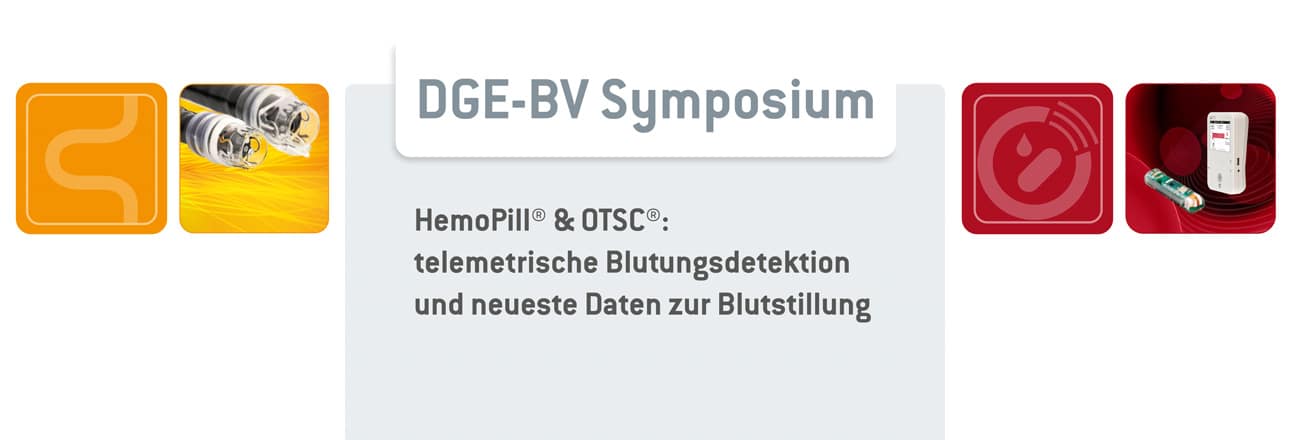OTSC® is recommended in current guidelines for the first-line treatment of large ulcers and the treatment of refractory ulcer bleeding
The 50th Conference of the German Society for Endoscopy and Imaging Procedures (DGE-BV) took place on April 8 – 10, 2021. Subject of the Symposium on April 8th was telemetric haemorrhage detection with the HemoPill® acute followed by two presentations on hemostasis with the OTSC® System. Here you can find the summary of the presentation by Prof. Schmidt. To rewatch the symposium (in German only) please click here: https://ovesco.com/de/dge-bv-symposium-2021/
Prof. Dr. Arthur Schmidt, Freiburg: OTSC System superior especially in large ulcers with fibrotic ulcer surface and in difficult anatomical location
A. Schmidt, University medical centre Freiburg, gave an overview of the current data situation and guideline recommendations for OTSC treatment of ulcer bleeding in his lecture and presented study data on OTSC vs. TAE as well as OTSC vs. surgery. Schmidt reported that the OTSC System is mainly used for large ulcers with a fibrotic ulcer surface as well as for difficult anatomical locations (e.g. rear wall of the duodenal bulb) where other endoscopic procedures (e.g. injection in combination with endoclips) reach their limits. Com-pared to the treatment with endoclips, OTSC clips offer several advantages: Higher compression force (Kato et al., GIE 2012), better hold in the fibrotic tissue (Mönkemüller et al., Endoscopy 2014), and better visuali-sation of the bleeding source through the spacer cap (Mönkemüller et al., Endoscopy 2015). In large ulcers, the aim is not to close the entire ulcer with the OTSC, but to compress the vascular stump at the surface of the ulcer with the OTSC, which can achieve sustained haemostasis (Schmidt et al., Gastrointest Endosc Clin N Am 2020).
Many studies are available on OTSC treatment for bleeding peptic ulcers, some of them with a large number of cases. However, these are almost exclusively retrospective. A meta-analysis of this retrospective data (Weiland et al, Minim Invas Allied Technol 2019), shows a technical success rate of 93.0%, a clinical success rate of 87.5% and a rebleeding rate of 8.3%. The updated ESGE guideline recommendations (Gralnek et al., 2021) now also provide an optional recommendation for first-line treatment with the OTSC System for the treatment of large ulcers (> 2 cm, with visible vascular stump > 2 mm or located in high-risk vascularised regions).
In refractory bleeding, there is one prospective randomised trial to date (STING Study, Schmidt et al., Gas-troenterology 2018) comparing OTSC (n = 33) with previous standard treatment (n = 33). The primary end-point of the study was the occurrence of further bleeding (persistent bleeding or recurrent bleeding). This occurred in 57.6% of patients in the standard treatment group and only in 15.2% in the OTSC group (p=0.001). Thus, the OTSC resulted in a relative risk reduction of 73.6%.
As guideline recommendations for persistent ulcer bleeding, there is a DGVS guideline (Goetz et al., 2017) that recommends the use of OTSC clips or haemostasis sprays if bleeding persists after standard treatment (open recommendation, strong consensus). The ESGE guideline updated in 2021 also recommends the use of OTSC or haemostasis spray/powder in cases of persistent or refractory bleeding.
Schmidt also presented a retrospective multicentre study on OTSC vs. TAE in the treatment of refractory ulcer bleeding (Kuellmer et al., UEGW 2020, submitted for publication) and a retrospective monocentric study on OTSC vs. surgery (Kuellmer et al., ESGE Days 2021).
In the comparative study OTSC vs. TAE, the patient groups were matched using propensity score matching so that 40 patients were available for each analysis. The analysis showed that OTSC is significantly superior to TAE in terms of both hospital mortality (5.0% vs. 22.5%) and length of ICU stay (5 days vs. 9 days). The clinical success (72.5% vs. 62.5%) and the rebleeding rate within 7 days (17.5% vs. 32.5%) were better with the OTSC, but the differences were not significant here. In summary, the study shows that TAE is associated with greater risks and a more severe disease course compared to OTSC treatment as a significantly more invasive procedure. The comparative study OTSC vs. surgery also showed significantly higher complication and mortality rates in the surgery group, as surgical care is a much more invasive procedure. These results are in line with the ESGE guideline (Gralnek et al., 2021) which recommends exhausting all endoscopic op-tions before considering trans-arterial embolisation (TAE) in cases of persistent bleeding. Surgical treatment is only recommended if the TAE fails or if a TAE is not possible.
Superiority of the OTSC® System in salvage treatment of refractory ulcer bleeding: Technical aspects and current data
A. Schmidt, University medical centre Freiburg, Freiburg
Symposium presentation at the virtuell DGE-BV congress 2021
 |


 Deutsch
Deutsch  Français
Français 